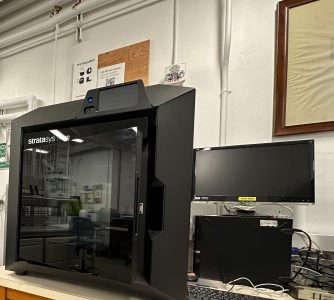Available 3D Printers
Manufacturer: Stratasys
Quantity: 1
Categories: 3D Printing, Plastics
Overview:
High-precision FDM printer designed for detailed parts and functional prototypes.
Technical Details:
Quantity: 1
Categories: 3D Printing, Plastics
Overview:
High-precision FDM printer designed for detailed parts and functional prototypes.
Technical Details:
Manufacturer: Tinkerine
Quantity: 7
Categories: 3D Printing, Plastics
Overview:
Affordable FDM printer ideal for basic prototyping and educational use.
Technical Details:
Quantity: 7
Categories: 3D Printing, Plastics
Overview:
Affordable FDM printer ideal for basic prototyping and educational use.
Technical Details:
- Print Technology: Fused Deposition Modeling (FDM)
- Build Volume: 220 x 165 x 220 mm (approximately 8.7 x 6.5 x 8.7 inches)
- Print Material: 1.75mm PLA (Matte White, Black, Grey)
- Support Material: None (Lattice via Tinkerine Suite)
- Layer Resolution: 0.05 – 0.3 mm
Manufacturer: Bambu Lab
Quantity: 1
Categories: 3D Printing, Plastics, Composites
Overview:
Advanced FDM printer with high-speed, multi-material, and multi-color capabilities.
Technical Details:
Quantity: 1
Categories: 3D Printing, Plastics, Composites
Overview:
Advanced FDM printer with high-speed, multi-material, and multi-color capabilities.
Technical Details:
- Print Technology: Fused Deposition Modeling (FDM)
- Build Volume: 256 x 256 x 256 mm (10.08 x 10.08 x 10.08 in.)
- Print Material: PLA, ABS, PETG, TPU, PA, PC, Fiber-reinforced (1.75mm)
- Support Material: Same as print or dissolvable (via AMS)
- Layer Resolution: 0.05 – 0.4 mm (7μm lidar precision)
Contact
Have questions? Email us at 3d@ece.ubc.ca.


